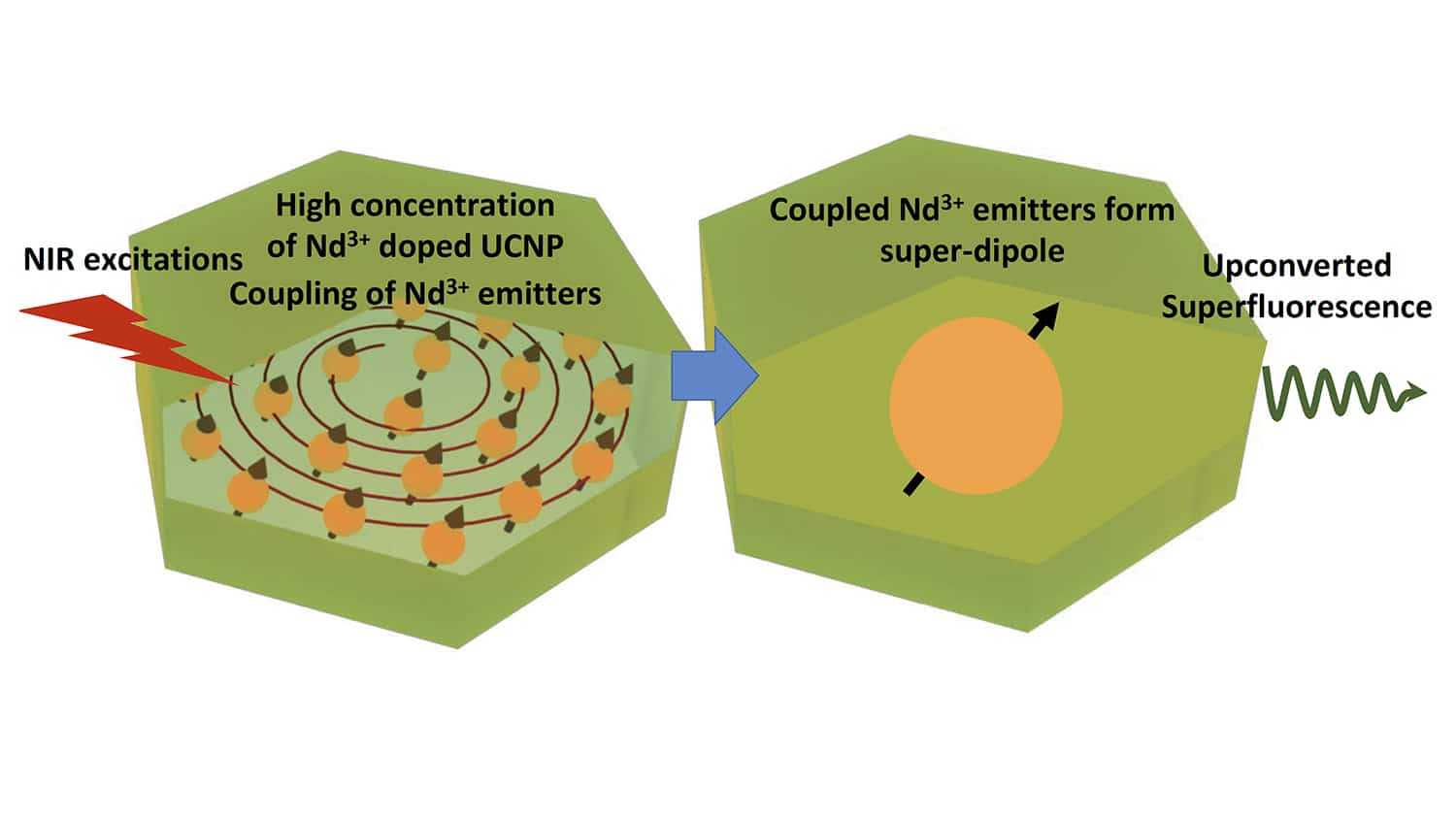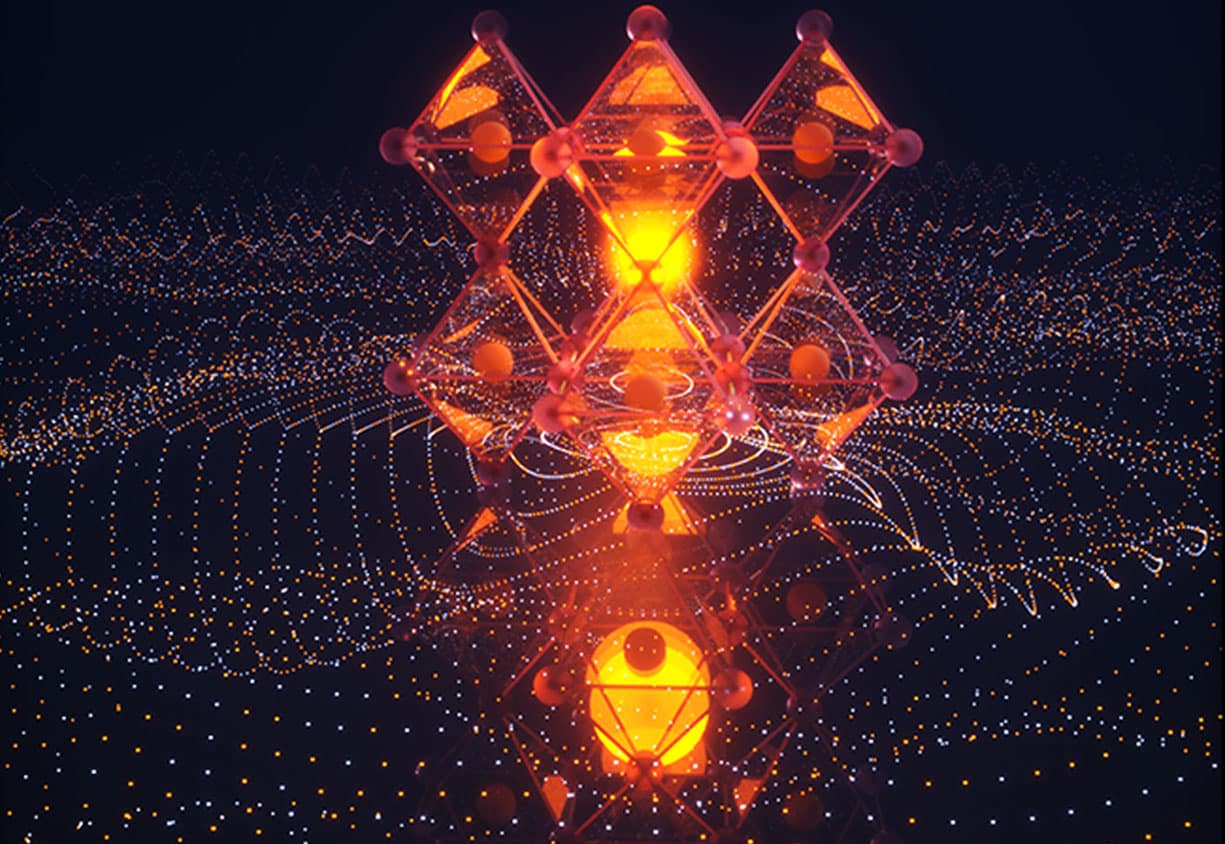‘Naturally Insulating’ Material Emits Pulses of Superfluorescent Light at Room Temperature

For Immediate Release
Researchers looking to synthesize a brighter and more stable nanoparticle for optical applications found that their creation instead exhibited a more surprising property: bursts of superfluorescence that occurred at both room temperature and regular intervals. The work could lead to the development of faster microchips, neurosensors, or materials for use in quantum computing applications, as well as a number of biological studies.
Superfluorescence occurs when atoms within a material synchronize and simultaneously emit a short but intense burst of light. The property is valuable for quantum optical applications, but extremely difficult to achieve at room temperatures and for intervals long enough to be useful.
The material in question – lanthanide-doped upconversion nanoparticle, or UCNP – was synthesized by the research team in an effort to create a “brighter” optical material. They produced hexagonal ceramic crystals ranging from 50 nanometers (nm) to 500 nm in size and began testing their lasing properties, which resulted in several impressive breakthroughs.
The researchers were initially looking for lasing, where light emitted from one atom stimulates another to emit more of the same light. However, they instead found superfluorescence, where first all the atoms align, then emit together.
“When we excited the material at different laser intensities, we found that it emits three pulses of superfluorescence at regular intervals for each excitation,” says Shuang Fang Lin, associate professor of physics at North Carolina State University and co-corresponding author of the research. “And the pulses don’t degrade – each pulse is 2 nanoseconds long. So not only does the UCNP exhibit superfluorescence at room temperatures, it does so in a way that can be controlled.”
Room temperature superfluorescence is hard to achieve because it is difficult for the atoms to emit together without being ‘kicked’ out of alignment by the surroundings. In a UCNP, however, the light comes from electron orbitals ‘buried’ beneath other electrons, which act as a shield and allow superfluorescence even at room temperature.
Additionally, UCNP’s superfluorescence is technologically exciting because it is anti-Stokes shifted, meaning that the emitted wavelengths of light are shorter and higher energy than the wavelengths that initiate the response.
“Such intense and rapid anti-Stokes shift superfluorescence emissions are perfect for numerous pioneering materials and nanomedicine platforms,” says Gang Han, professor of biochemistry and molecular biotechnology at University of Massachusetts Chan Medical School and co-corresponding author of the research. “For example, the UCNPs have been widely used in biological applications ranging from background noise-free biosensing, precision nanomedicine and deep-tissue imaging, to cell biology, visual physiology, and optogenetics.
“However, one challenge to current UCNP applications is their slow emission, which often makes detection complex and suboptimal. But the speed of anti-Stokes shift superfluoresence is a complete game changer: 10,000 times faster than the current method. We believe that this superfluorescence nanoparticle provides a revolutionary solution to bioimaging and phototherapies that await a clean, rapid and intensive light source.”
UCNP’s unique qualities could lead to its use in numerous applications.
“First, room temperature operation makes applications much easier,” Lim says. “And at 50 nm, this is the smallest superfluorescent media currently in existence. Since we can control the pulses, we could use these crystals as timers, neurosensors or transistors on microchips, for example. And bigger crystals could give us even better control over the pulses.”
The paper, “Room Temperature Upconverted Superfluorescence,” appears in Nature Photonics. The research was supported by the U.S. Army Research Office under W911NF2110283. Kai Huang, postdoctoral researcher at UMass Chan Medical School, is first author.
-peake-
Note to editors: The paper’s abstract follows.
“Room Temperature Upconverted Superfluorescence”
DOI: 10.1038/s41566-022-01060-5
Authors: Kai Huang, Ling Huang , Gang Han, University of Massachusetts Chan Medical School; Kory Kevin Green, Hans Hallen, Shuang Fang Lim, North Carolina State University
Published: Aug. 29, 2022 in Nature Photonics
Abstract:
Superfluorescence (SF) is a unique quantum optics arising from the assembly of self-organized and cooperatively coupled emitters. SF produces a short and intense burst of light, ideal for various applications in nanophotonics, and optical computing. However, due to the prerequisite for cooperative emitter coupling, SF was conventionally observed in a Stokes shifted manner under cryogenic conditions in limited systems (e.g., atomic gases, perovskite nanocrystal superlattices). Here we show that room temperature anti-Stokes shifted SF is achieved in a few randomly assembled or in a single lanthanide-doped upconversion nanoparticle (UCNP). Moreover, upconverted SF has a 10,000-fold accelerated nano-second lifetime (? = 46 ns of SF v.s. ? = 455.8 ?s of normal upconversion luminescence), overcoming the slow decay of conventional upconversion systems. Therefore, the conceptual room temperature anti-Stokes SF not only lays the foundation for an ultrafast upconversion, it also paves a straightforward way to a wide variety of applications that have been limited by the existing super-fluorescence system.


